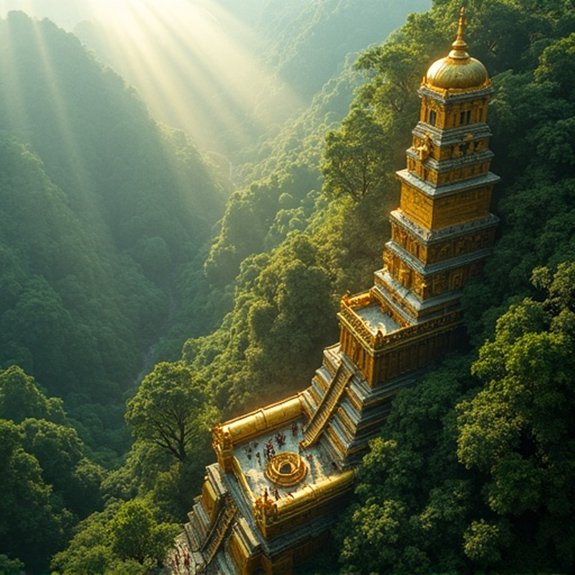The Legend of El Dorado: Gold City Explored
The golden chief‘s body shimmered as he dove into Lake Guatavita‘s dark waters, washing away precious dust meant for the goddess Chía. This Muisca ritual would spark centuries of obsession, transforming a sacred ceremony into Europe’s most notorious treasure hunt. Explorers drained lakes, destroyed landscapes, and sacrificed fortunes chasing what they’d reimagined as El Dorado—a city of solid gold. But the truth behind this legend isn’t what conquistadors expected.
Introduction

Everyone’s heard whispers of El Dorado—that legendary city of gold that drove conquistadors mad with greed and sent countless explorers to their deaths in the Amazon rainforest. The myth originated with the Muisca people of Colombia, who’d perform a ritual where their chief, covered in gold dust, would plunge into Lake Guatavita while throwing precious offerings into the water. Spanish conquistadors witnessed this ceremony in the 16th century and transformed it into tales of an entire golden city.
What began as a person—”el dorado” meaning “the golden one“—morphed into a place that’s captivated imaginations for five centuries. The legend’s evolved from a lake ceremony to a city, then to an entire kingdom, growing more elaborate with each failed expedition that couldn’t find it.
Muisca Ceremonial Lake Rituals
When the Muisca confederation ruled the highlands of present-day Colombia, they’d transformed Lake Guatavita into a sacred site where their most important ritual unfolded. The ceremony centered on their new ruler, who’d cover his body in gold dust before boarding a raft laden with emeralds and gold offerings. As priests burned incense and played instruments, the gilded chief would plunge into the lake’s cold waters, washing off the precious coating while attendants threw treasures into the depths.
This ritual honored Chía, the goddess they believed lived beneath the surface. The Muisca performed these ceremonies during leadership changes and times of crisis, believing the offerings would guarantee prosperity and divine protection. Spanish conquistadors who witnessed accounts of these rituals became obsessed with the lake’s rumored underwater wealth.
Notable Cases or Sightings

Three major expeditions between 1545 and 1969 attempted to drain Lake Guatavita and recover its legendary treasures. In 1545, Hernán Pérez de Quesada‘s crew cut a notch in the rim, lowering water levels by sixty feet and retrieving some gold. Antonio de Sepúlveda‘s 1580 attempt proved more ambitious—he employed 8,000 indigenous workers to dig a channel, dropping the lake’s level by sixty-six feet before the cut collapsed, killing many laborers.
The most successful venture came in 1911 when British company Contractors Limited completely drained the lake using tunnels. They’d recovered £500 worth of artifacts before the exposed mud hardened like concrete, making further excavation impossible. Colombia’s government banned all treasure hunting at Guatavita in 1969, declaring it a protected cultural site.
Common Theories or Explanations
While Lake Guatavita’s ritual offerings explain some El Dorado stories, historians have traced the legend’s evolution through multiple cultural misunderstandings. Spanish conquistadors conflated various indigenous ceremonies into one mythical city, transforming a Muisca chief’s gold-dusting ritual into tales of vast golden kingdoms.
Anthropologists suggest the legend persisted because it served conquistadors’ needs to justify expeditions and secure funding. Each failed search spawned new theories, pushing El Dorado’s location further into unexplored territories. Some scholars argue it became a composite myth, incorporating elements from different indigenous cultures’ wealth displays.
Modern researchers believe El Dorado represents European projection of greed onto South American geography. They’ve identified how mistranslations, exaggerated reports, and wishful thinking created a self-perpetuating legend that drove centuries of exploration despite no evidence of such a city existing.
Frequently Asked Questions
How Much Money Has Been Spent Searching for El Dorado Throughout History?
Historians can’t calculate the total amount spent searching for El Dorado over centuries. Expeditions by Spanish conquistadors, British explorers, and modern treasure hunters have likely cost hundreds of millions in today’s dollars, though exact figures remain unknown.
Which Modern Technologies Are Currently Being Used to Search for the City?
Modern explorers use satellite imaging, LiDAR technology, ground-penetrating radar, and drones to scan dense jungle areas. They’ve combined these with AI-powered data analysis and underwater sonar systems to search Colombia’s lakes and rivers.
Are There Any Legal Restrictions on Searching for El Dorado Today?
Yes, explorers face numerous legal restrictions today. They’ll need permits from local governments, must respect indigenous territories, and can’t disturb protected archaeological sites. Environmental laws in Amazon regions also limit where searchers can explore.
What Movies or Books Have Been Inspired by the El Dorado Legend?
The El Dorado legend’s inspired numerous works including Werner Herzog’s film “Aguirre, the Wrath of God,” Disney’s animated “The Road to El Dorado,” Clive Cussler’s novels, and Edgar Allan Poe’s poem “Eldorado” among others.
Can Tourists Visit Locations Associated With El Dorado Expeditions?
Yes, tourists can visit Colombia’s Lake Guatavita, where Muisca chiefs performed gold ceremonies. They’ll also find museums in Bogotá showcasing pre-Columbian gold artifacts. Venezuela’s Orinoco region and Peru’s Manu National Park offer expedition-related sites too.


